Sleek 2023 Hyundai Ioniq 6 Electric Sedan Breaks Cover
New car builds on the corporate EV platform, adding new comfort, convenience, and safety features
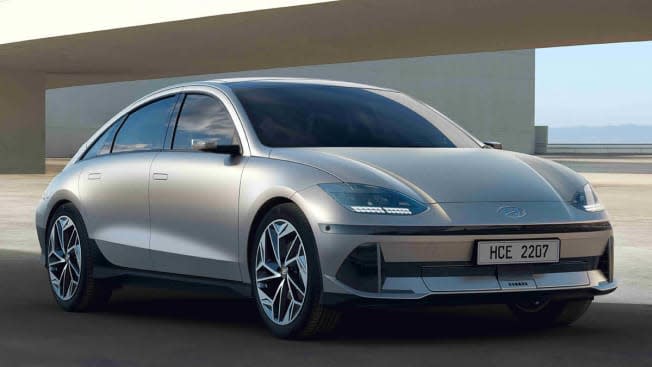
By Jeff S. Bartlett
Hyundai unveiled its next electric vehicle online, the sleek Ioniq 6 sedan. The sedan shown via video is a world car, meaning it will be sold around the globe with some features and specifications tailored to different countries.
For now, we have the overall highlights to share, with U.S.-market information to come closer to its early 2023 on-sale date.
The car is based on the E-GMP architecture that underpins the latest generation of Hyundai electric vehicles, like the Ioniq 5. Many key specifications and features are common with that impressive model, but it also brings swoopy styling and innovations, like reclining seats and the automaker’s latest driver assist features. Plus, it is the brand’s first model to offer over-the-air updates to modify many elements, from controls to infotainment.
The company claims the Ioniq 6 will be one of the most energy-efficient EVs on the market, but it has not yet released the range based on the methodology used in the U.S.
Production begins late 2022. The on-sale date for the U.S. has not been announced, but we expect it to arrive sometime in the middle of 2023.
Here is what we know so far.
What it competes with: BMW i4, Tesla Model 3
What it looks like: A Mercedes-Benz or an Apple Magic mouse
Powertrains: single or dual motor; single-speed transmission; 53- and 77.4-kWh battery, rear- and all-wheel drive
Price: $45,000-$60,000 (estimated)
On sale: Spring 2023
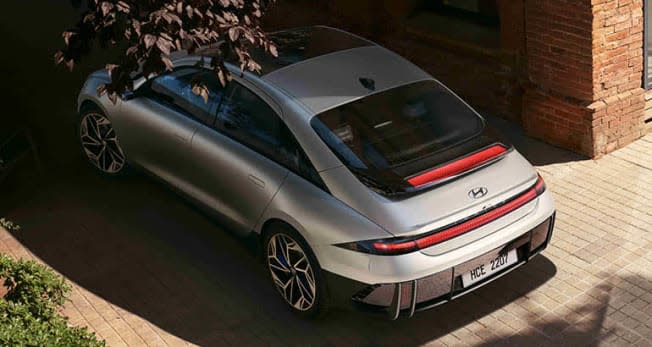
The 2023 Hyundai Ioniq 6 may look like a hatchback, but it has a trunk.
Photo: Hyundai
CR's Take
Hyundai continues to expand its second-generation electric car portfolio. We are impressed with the Ioniq 5, and its corporate cousins, the Genesis GV60 and Kia EV6. All three are delightful to drive, with handling agility, rapid acceleration, and good range. In short, they demonstrate how appealing EVs can truly be.
The Ioniq 6 looks to take the core mechanical bits and apply them to a sedan, rather than an elevated hatchback. The swoopy design looks upscale and should broaden the appeal for the automaker’s EVs.
Outside
Shaped much like a low-profile computer mouse, the Ioniq 6 was designed with a strong emphasis on aerodynamics, which should help minimize wind noise and extend range. It stands out from the existing Hyundai models, with its smooth, simple surface lines. From the side, it almost looks like a Mercedes-Benz, especially the CLS.
It rides on a similar wheelbase to the Ioniq 5, but its overall length is about 8 inches longer.
Being both futuristic and upscale should help draw buyers to this zero-emissions model.
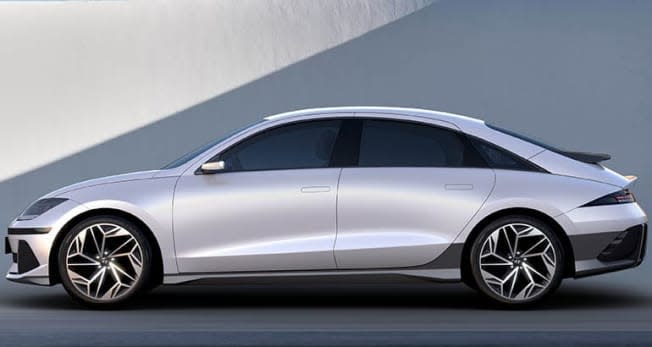
The Hyundai Ioniq 6 reminds of a Mercedes-Benz from the side.
Photo: Hyundai
Inside
The cabin design and control layout is a dead ringer for the Ioniq 5. It uses two 12-inch screens that seemingly connect, with one for the instrument panel and a touch screen for the infotainment system.
Below that is a row of physical buttons, complete with a volume knob and hard keys for common infotainment functions, like Map and Media. There is a star button that can be custom configured—a neat touch we have appreciated on other models for setting our favorite radio station or other function. Among the settings within the driver’s control are the ability to adjust the steering effort, accelerator pedal sensitivity, and motor responsiveness.
The Ioniq 6 will offer the traditional roster of entertainment and connected features, including Android Auto/Apple CarPlay, multi-device Bluetooth connectivity, and Hyundai’s Bluelink telematics service. The navigation system provides real-time guidance on electric range, and it can direct the driver to charging stations along a route. A Bose stereo upgrade, with a subwoofer, is optional.
The seats are said to be about 30 percent thinner than those fitted to Hyundai’s conventional models to increase interior space, which already benefits from the flat floor enabled by the dedicated electric-car platform. Optional “Relaxation Comfort” seats for the front row allow significant reclining (think: first class on an airplane) for resting and possibly napping when parked.
Hyundai employs some audio wizardry to tailor background sounds in the cabin to the driving situation. This includes a “space-ship-like” sound.
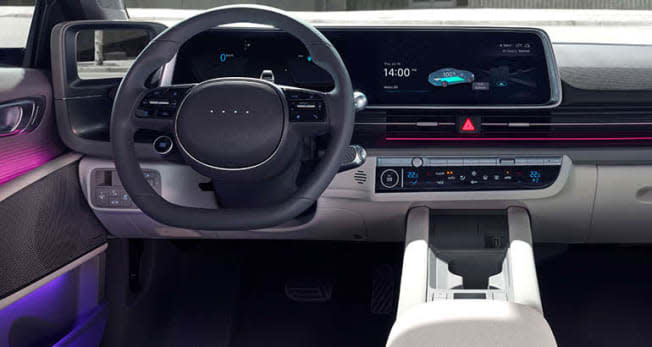
The clean interior design builds on the two-screen look used in recent Hyundai and Kia models.
Photo: Hyundai
What Drives It
The Ioniq 6 features a 53- or long-range 77.4-kWh battery, and it can be configured in rear- and all-wheel drive. The top configuration uses two motors, for a combined 320 hp, and is capable of zipping from 0-60 mph in about 5 seconds. (The Ioniq 5 we tested sprinted to 60 mph in a swift 4.7 seconds.)
Our dual-motor Ioniq 5 delivers instant thrust off the line (without being neck-wrenching like the Model Y), followed by a linear flow of effortless power. The EPA-rated driving range is 256 miles for our all-wheel-drive test model, and 303 miles for the single-motor, rear-wheel-drive versions with the 77.4-kWh battery. Those figures reveal the ballpark that the Ioniq 6 is expected to play in. As with other EVs that have large batteries, it takes a full overnight of charging to replenish a deeply depleted battery at home using a typical 240-volt connector.
The E-GMP architecture allows for both 400- and 800-volt DC fast charging. Hyundai claims that with a 350-kW charger, Ioniq 6 can charge from 10 percent to 80 percent in just 18 minutes. (Note that the maximum acceptance rate for the Ioniq 5 is 235 kW.) Like the Ioniq 5, the Ioniq 6 can charge other devices, including cars, with its vehicle-to-load (V2L) capabilities. There is an exterior power outlet, as well as one under the second-row seat for charging laptops and other devices.
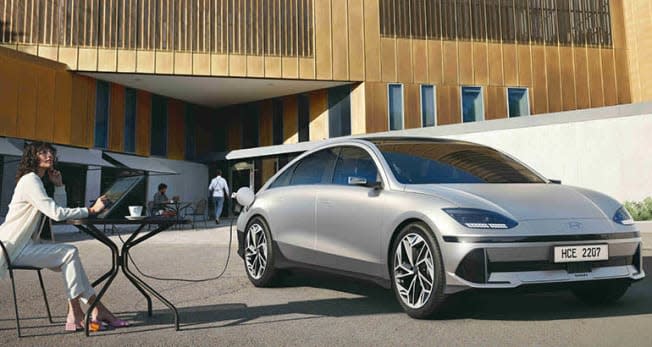
The massive battery pack can be used to power devices, both inside and outside of the vehicle.
Photo: Hyundai
Safety and Driver Assistance Systems
The latest Hyundai SmartSense active driver assistance suite is standard, with forward collision warning, automatic emergency braking with pedestrian and cyclist detection, blind spot warning, and adaptive cruise control with the ability to automate lane changes. As on other Hyundais, there is the convenient “safe exit” feature that monitors along the car’s flanks when parked and can warn if a passenger is about to open the door into traffic.
SEL and Limited trims add several features, including active steering to help avoid a collision with opposing or crossing traffic.
There is also a blind spot monitor that is activated by the turn signal. It shows a video feed of along the side of the car to aid in a lane change.
And there are automated parking features that allow the driver to remotely direct the car in and out of parallel, perpendicular, and diagonal parking spots.
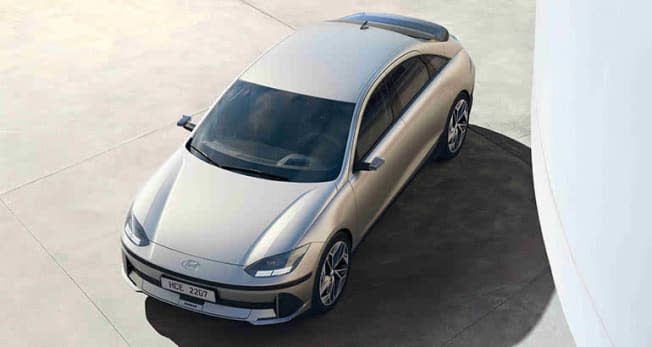
Viewed from the top, the hood sculpting gives the otherwise smooth exterior some added character.
Photo: Consumer Reports
2022 Hyundai Ioniq 5
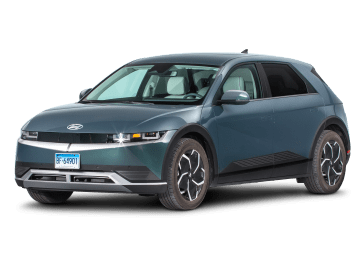
More from Consumer Reports:
Top pick tires for 2016
Best used cars for $25,000 and less
7 best mattresses for couples
Consumer Reports is an independent, nonprofit organization that works side by side with consumers to create a fairer, safer, and healthier world. CR does not endorse products or services, and does not accept advertising. Copyright © 2022, Consumer Reports, Inc.

